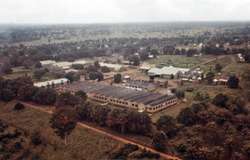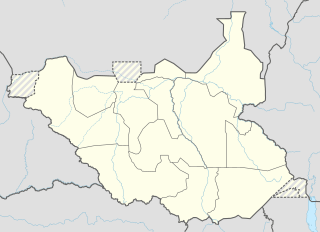Nzara, South Sudan
Nzara is a town in South Sudan. It lies 15 mi (24 km) to the northwest of Yambio by road, and is 25 km (15m) from the border with the DR Congo.
Nzara | |
|---|---|
 The cotton factory in Nzara, suspected to be the source of the 1976 Ebola outbreak. | |
 Nzara Location in South Sudan | |
| Coordinates: 4.647°N 28.258°E | |
| Country | |
| State | Western Equatoria State |
| County | Nzara |
Nzara was the industrial center of the Zande Scheme during the Anglo-Egyptian colonial period.[1] The Government of South Sudan has since 2006 intended to revive the agro-industrial complex.[2]
Nzara was the site of the world's second recorded outbreak of the Ebola virus disease. In five months starting in June 1976, 151 people in the region died of the disease.[3]
Military base
Nzara served as the operational headquarters of the 4th Division of the Uganda People's Defence Force (UPDF), the Ugandan contingent in Operation Rudia II. This was part of the regional campaign military against the Lord's Resistance Army (LRA).[4] After the LRA defeat at Camp Swahili, the UPDF ceded overall control of the operation to the Armed Forces of the Democratic Republic of the Congo (DRC) and moved the bulk of its forces to Nzara in March 2009.[5] About 2000 UPDF troops remained in the DRC, north of Faradge, and Nzara-based attack helicopters supported them in engagements against increasingly concentrated LRA forces.[5] When LRA Major General Caesar Acellam was captured in May 2012, he was flown from Djema in the Central African Republic to Nzara where he gave a televised interview.[6]
According to a 2012 published report, Nzara has housed one of the four Combined Operations Fusion Centers where intelligence and operations have been coordinated among the anti-LRA coalition.[7]
References
- Hance, William A (Apr 1955). "The Zande Scheme in the Anglo-Egyptian Sudan". Economic Geography. 31 (2): 149–156. doi:10.2307/142184. JSTOR 142184.
- Embassy Khartoum. "Goss Trade Ministry To Develop Private Sector". US Department of State. Retrieved 15 August 2013.
- Emmer, Rick (2006). Virus hunter. Philadelphia: Chelsea House Publishers. ISBN 9781438123578.
- Embassy Kampala (15 Jun 2009). "Uganda/drc: Operation Rudia II Update". United States Department of State. Retrieved 15 August 2013.
- Embassy Kampala (15 Apr 2009). "Uganda/DRC: Operation Rudia II Update". US Department of State. Retrieved 15 August 2013.
- Delany, Max (13 May 2012). "Uganda captures high-ranking Lord's Resistance Army member". AFP. Retrieved 15 August 2013.
- Agger, Kasper (May 2012). "Mission in the Balance" (PDF). Retrieved 15 August 2013.